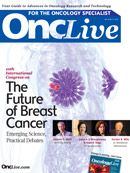Publication
Article
Oncology Live®
Expanding the Scope of Cystoscopy: Imaging Agent Illuminates More Lesions
Author(s):
An interview with Neal D. Shore, MD, discussing expanding the scope of cystoscopy and the optical imaging agent Cysview.

Neal D. Shore, MD
Although cystoscopy is a mainstay in diagnosing bladder cancer and monitoring its recurrence, researchers have been seeking to improve upon its ability to detect early evidence of cancer, particularly flat lesions and small papillary tumors.
Last year, the FDA approved the optical imaging agent Cysview™ for use with photodynamic blue light cystoscopy in conjunction with the standard white light cystoscopy.
The agent, which contains hexaminolevulinate hydrochloride, is injected into the bladder through a catheter. It enters the bladder mucosa, where it accumulates preferentially in malignant cells. When illuminated with blue light from the cystoscope, the diseased cells emit red fluorescence, improving the clinician’s ability to see potentially troublesome growths.
The approval was based on pivotal study data that demonstrated blue light cystoscopy improved detection by 16% in patients with Tα and/or T1 lesions when compared with white light cystoscopy. The most common adverse event was bladder spasms, which were reported by less than 3% of participants.
The data showed that Cysview “significantly improves detection of papillary bladder cancer, leading to a more complete resection of bladder cancer” in patients with initial and recurrent disease, H. Barton Grossman, MD, a professor in the Department of Urology at the MD Anderson Cancer Center in Houston, Texas, and lead investigator of the trial, said in a press release when the agent was approved.
Cysview is designed for use with the Karl Storz D-Light C Photodynamic Diagnosis (PDD)™ system. GE Healthcare, a unit of General Electric Company, licensed Cysview from Photocure ASA, a Norwegian pharmaceutical and medical device company. The agent is approved in Europe and marketed as Hexvix.
Last fall, Neal D. Shore, MD, became the first urologic oncologist in the United States to begin using Cysview.
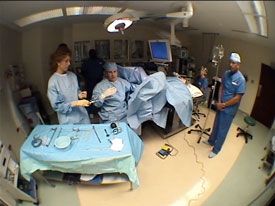
Dr Shore, center, explains use of Cysview during cystoscopy.
He recently demonstrated its use in a live cystoscopy accessible through a virtual presentation from the Parkway Surgery Center, an outpatient facility in Myrtle Beach, South Carolina, that is part of Atlantic Urology Clinics. The patient was a 76-year-old woman who had several tumors resected and showed evidence of recurrence 6 months later. Using the Cysview technology, Shore confirmed 4 tumors, including 2 that he resected immediately and 2 smaller, nonmuscularly invasive tumors that he cauterized.
Shore, who is managing partner at Atlantic Urology and director of its research arm, has participated in more than 100 clinical trials involving urinary tract cancers. After performing up to 75 cystoscopies using Cysview, he is enthusiastic about the technology.
“If I can do a better job of performing a complete resection, I theoretically can reduce my short-term recurrence rates and then hopefully that will impact long-term recurrence rates,” Shore said in an interview with OncLive. “And if I can do that, I’m also reducing the number of times patients will require tumor resection with its associated morbidity and risks.”
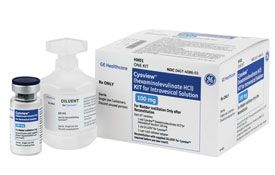
The Cysview kit contains 2 vials and a catheter adapter.
Onc: Please explain why you feel Cysview represents an advance over white light cystoscopy.
Shore: It allows the treating urologist to identify more potential malignant tissue with greater certainty than without using it. And because of that, it also allows you to resect the tissue that is potentially malignant. It allows you to identify and resect the malignant tissue in a way that may have been missed previously. The end result is it allows any urologist who has been resecting bladder tumors for a long period of time to improve his outcomes.
The bigger tumors you’ll see obviously with the white light. It is the smaller lesions, such as the 1- to 3-millimeter ones or those that are almost fl at that you will only see with the blue light and the fl uorescence uptake. The very obvious tumors on blue light will be obvious on white light as well.
If you can detect and remove more tumor, then the next time you repeat—a surveillance cystoscopy three or four months later— you’ve theoretically performed a more complete resection. But if I had missed them initially, and now I visualize a previously missed lesion that has enlarged, I would conclude, ‘Oh, there’s recurrence.’ But, in reality, it wasn’t so much recurrence as that I just never treated it earlier.
This observation is very important because, if I’m the patient, now I’m not being scheduled for a repeat anesthesia and a repeat attempt at eradicating that tumor, which I’m now calling “recurrent” as opposed to having been missed earlier.
What is the best use of Cysview?
I think that it is well suited for patients who are undergoing an initial bladder tumor resection, and especially those who have multiple tumors. For any initial resection of someone who has more than two or three tumors, I think it could be very helpful in picking up the full margin of the tumor as well as any small, additional satellite tumors that may be otherwise missed with standard white light cystoscopy.
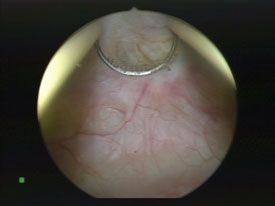
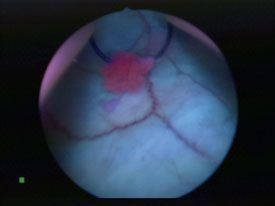
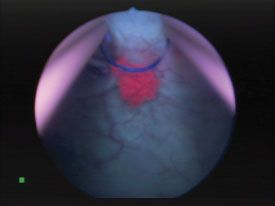
Tumor area near resection tool shown with white light cystoscopy, top, compared with red fluorescence of Cysview, center and bottom.
Where does Cysview fit in the treatment timeline?
Once you’ve done a diagnostic cystoscopy and the patient has multiple tumors, I think then the installation of Cysview upon the first initial resection is extremely beneficial. When you then go back and you inspect the bladder and there’s no evidence of any recurrent disease, I think that one could potentially hold off on doing the Cysview. If you have concern that there is recurrent disease, then I think the Cysview has another very valuable role, specifically in the setting of an abnormal cytology or FISH [fluorescence in situ hybridization].
The prescribing information states that Cysview is not intended for repetitive use. Do you agree with that, and what would constitute repetitive use?
That’s a good question. You don’t want to use Cysview in the setting within three months of significant infection, or anything that can cause an inflammatory change, such as prior intravesical therapy or a recent resection. So, to me, the answer is that it is not for repetitive use within three months of any one of those things, the setting within three months of a bladder tumor resection, or within three months of intravesical installation of therapy, be it BCG [bacillus Calmette-Guérin] or mitomycin, or three months of a recent infection because it creates too much false—positive pickup of the fluorescence in the tissue.
In your experience, have there been adverse events among the patients with whom you’ve used this agent?
We haven’t seen any adverse events related to the installation of the Cysview. Zero. We’ve seen no one complain of any discomfort upon installation of the medication, and we’ve seen no change in anything related to the installation of the medication itself. We’ve had no systemic reactions. We’ve had no irritative voiding symptom reactions different from the mere fact of instrumenting somebody with a cystoscope, resecting a tumor, or biopsying the bladder wall.
How do you integrate Cysview into your practice?
Prior to using Cysview, we weren’t using anything comparable. There’s no comparable workfl ow for this therapeutic application or this diagnostic application. So, essentially, all we had to do for this is have the patients come in at the usual expected time for checking in.
But immediately upon check-in, we want to make sure we are set up in our framework to have them catheterized to place the medication because we’re aiming for a bladder dwell time of about 60 minutes.
The change was getting the patients when they came in, not really trying to have them come in too much earlier but early enough so they can have the medication instilled in their bladder, do their normal paperwork, preoperative preparation, talk to the nurses, fill out preoperative information, and meet with the anesthesiologist. All that’s going on, but prior to any of that we have the medication instilled.
You have to use Karl Storz D-Light C PDD System equipment, including a light cord that gives you the blue light wavelength in conjunction with the white light wavelength. And, of course, that light cord needs to be adaptable to the Storz cystoscopic equipment.
If you already have the Storz white light equipment, it’s not a significant step to upgrade. If you don’t have any Storz equipment, then it would be more involved in making sure you had their cystoscopes in addition to the ability to have the blue light with the white light capability.
